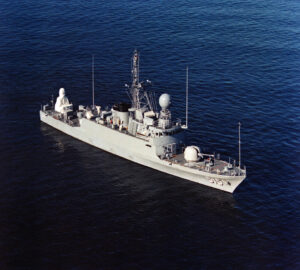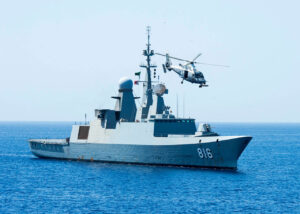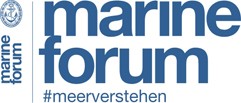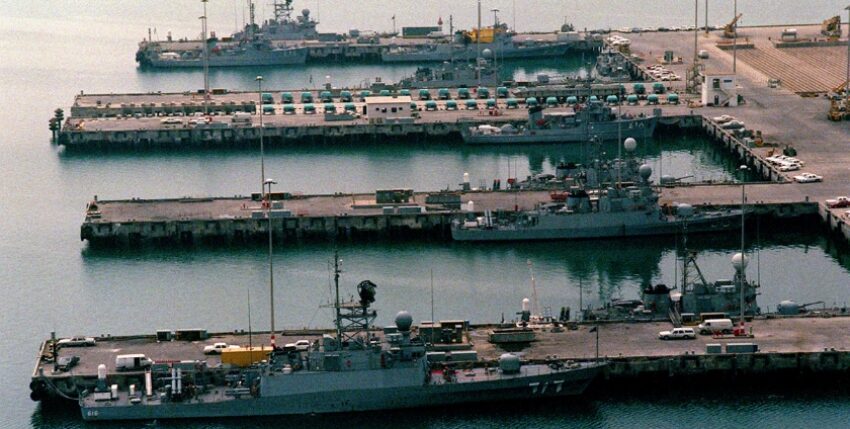The modern units of the Saudi Navy.
The Kingdom of Saudi Arabia (al-Mamlaka al-ʿarabīya as-saʿūdīya) is an absolute monarchy that occupies most of the Arabian Peninsula between the Red Sea and the Persian Gulf. The country, which has been undergoing a major social upheaval for several years, is one of the richest states in the world.
Saudi Arabia, which has a population of just under 37 million, has predominantly modern armed forces that are among the most powerful in the Middle East (Saudi Arabia is the largest military power on the Arabian Peninsula itself). The armed forces of the Kingdom of Saudi Arabia (al-Quwwāt al-musallaḥa al-malakiyya as-saʿūdiyya) have five branches, comprising the army, navy, air force, national guard, air defence and strategic missile forces. They have 227,000 personnel, including female soldiers since 2021.
The Saudi Navy
Saudi Arabia's navy, the Royal Saudi Navy (al-Quwwāt al-Baḥriyya al-Malakiyya as-Saʿūdiyya), also known as the RSNF (Royal Saudi Naval Forces), comprised around 13,500 soldiers in 2021. The Saudi Navy was established on a small scale from 1960 (28 years after the founding of the state of Saudi Arabia). It was not until the 1970s that the RSNF was expanded into a modern navy thanks to support from the USA (in the form of the SNEP programme - Saudi Naval Expansion Program) and France (the French naval support bears the programme name Sawari). Thanks to Western support, the number of personnel grew from less than 1,000 to around 9,500 between 1974 and 1991.

The RSNF has its headquarters in the Saudi capital Riyadh. The Saudi Navy has a Western Fleet based at the King Faisal Naval Base in Jeddah on the Red Sea and an Eastern Fleet based at the King Abdulaziz Naval Base in al-Jubail on the Persian Gulf. Both fleets are each equipped with combat ships, supply ships, marines, special forces, naval aviation and administrative units. Until a few years ago, the more powerful part of the Saudi naval units (including French-built frigates) was based in the Red Sea. The Persian Gulf was mostly home to American-built corvettes and patrol boats, which are nearing the end of their service life after several decades. A changed geopolitical situation and the increased threat posed by Iran and its proxy organisations have now given the Eastern Fleet in the Gulf greater importance again. A fleet renewal programme launched around 2014, which is now officially known as the Saudi Naval Expansion Programme (SNEP II), is specifically aimed at modernising the Eastern Fleet in the Persian Gulf. As part of Saudi Vision 2030 (the planned economic and social transformation of the country initiated by the government), a total of USD 20 billion has been earmarked for fleet renewal in the Saudi Navy.
With European support
Between 1980 and 1982, the Saudi Navy commissioned nine Al Sadiq-class patrol boats built by Peterson Builders in Sturgeon Bay, Wisconsin. With a length of 58 metres and a displacement of 495 tonnes, the units powered by a General Electric LM 2500 gas turbine are quite heavily armed for boats of this size. The equipment includes a 76-mm gun, four launchers for Harpoon missiles, a Phalanx close-range defence system, two 20-mm machine guns, an 81-mm mortar, two 40-mm grenade launchers and two triple torpedo launchers.

In addition to the nine patrol boats of the Al Sadiq class, there are four units of the Badr class, which were built by the Tacoma Boatbuilding Company in the US state of Washington and commissioned between 1981 and 1983. Similarly armed to the Al Sadiq class, but with a length of 75 metres and a displacement of 1,035 tonnes, the Badr class is classified as a corvette. The Badr class has a similar propulsion system and basically the same armament as the Al Sadiq class (with eight instead of four Harpoon launchers), but with greater seaworthiness.
In 1985/86, the RSNF received four Al Madinah-class frigates built in France by Arsenal de Marine in Lorient and CNIM in La Seyne, each with a length of 115 metres and a displacement of 2,870 tonnes. The ships are powered by SEMT Pielstick diesel engines and are equipped with a French-made 100-mm gun, eight Otomat anti-ship missiles, eight Crotale anti-aircraft missile launchers (with 26 missiles in total), two 40-mm anti-aircraft guns and four torpedo launchers. An Aérospatiale SA 365 Dauphin 2 helicopter can be embarked thanks to the flight deck and hangar. On 30 January 2017, the type ship Al Madinah was damaged in an attack by Houthi rebels, in which two members of the Saudi navy lost their lives and two others were injured. According to the Saudi navy, the frigate was the victim of a suicide attack using three boats, while the Houthis claimed to have fired at the ship with a sea-target missile.

The most powerful units of the Saudi Navy to date are the three guided missile frigates of the Al Riyadh class, which are an enlarged version of the French La Fayette class. The 133 metre long, 4,650 tonne displacement ships were built by DCN in Lorient and entered service with the RSNF between 2002 and 2004. In addition to a 76 mm OTO Melara gun, each Al Riyadh-class ship is armed with eight MBDA Exocet MM40 Block II anti-ship missiles, two eight-cell VLS launch systems for Aster 15 anti-aircraft missiles and four 533 mm torpedo tubes at the stern for F17 heavyweight torpedoes from DCNS. The hangar and flight deck allow the embarkation of a medium-sized naval helicopter such as the AS 365 Daupin or the NH90 helicopter from Airbus.
Furthermore, three British Sandown-class minesweepers, built by Vosper Thornycroft in Woolston, were put into service with the RSNF between 1991 and 1994. In addition to a large number of smaller patrol boats, the fleet also includes two Boraida-class supply vessels, which are a modified version of the French Durance-class. The two units, each 135 metres long and displacing 11,400 tonnes, were built at CN la Ciotat near Marseille and entered service in 1984/85.
American design
Back in 2011, Lockheed Martin offered the Saudi Navy a heavily upgraded variant of the Freedom-class Littoral Combat Ship, known as the Multi-Mission Surface Combatant (MMSC). In contrast to the US Navy's Freedom-class, whose equipment can be modified in port using mission-specific modules, the RSNF favours ships with permanently installed systems. In October 2015, the Saudi Navy applied to purchase four MMSC units through a Foreign Military Sales (FMS) deal worth up to USD 11.25 billion. In May 2017, the ship sale was accepted by the US Navy and a Letter of Offer and Acceptance was signed. Just like their American sister ships, the four units will be built at Fincantieri Marinette Marine in Marinette, Wisconsin. The first steel cut took place in October 2019. The Saudi ships do not have the two forward bays for installing mission modules, but they do have the aft mission bay with stern ramp.

The original plan was to purchase the AEGIS system and a version of the Arleigh Burke-class SPY-1 radar, but this was cancelled for cost reasons. Instead, the 118 metre long, 3,600 tonne displacement units will each be equipped with a TRS-4D radar from Hensoldt. The ships will be powered by a CODAG propulsion system consisting of two Rolls-Royce MT30 36 MW gas turbines, two Colt-Pielstick 16PA6B 6.8 MW diesel engines, which will operate on four Rolls-Royce/Kamewa 153SII/153BII waterjets, enabling a theoretical maximum speed of 47 knots to be achieved. The armament will consist of two Mk 41 VLS systems with eight launch cells each, which can carry either 16 SM-2 or 64 ESSM anti-aircraft missiles. In addition, there will be a 76 mm OTO Melara gun, a SeaRAM short-range system and Harpoon Block II anti-ship missiles. The hangar has space for an MH-60R Seahawk helicopter. So far, the names of the first three units are known: Saud (820), Fahd (822) and Abdullah (824). All four units are to be delivered by 2026.
Al Jubail class
In July 2018, the Saudi Navy awarded the Spanish shipyard and defence company Navantia a contract to build five Avante 2200 corvettes. This is an enlarged version of the Guaiquerí-class patrol boats, four of which were built by Navantia and put into service with the Venezuelan Navy in 2011/12. The slightly larger Saudi version is 104 metres long and displaces 2,500 tonnes. The five units ordered by Saudi Arabia were built at the Navantia shipyard in San Fernando (near Cadiz) between 2019 and 2021 and have since been delivered to the RSNF. The ships were built in a joint venture between Navantia and the state-owned Saudi Arabian Military Industries (SAMI). In addition to the construction, this agreement also covers the maintenance of the units for a period of five years, with an option to extend for a further five years. The Al Jubail-class corvettes are capable of submarine hunting as well as anti-aircraft missions and combating surface vessels. In addition to a 76 mm gun, the ships are equipped with a Mk 41 VLS with 16 cells for 64 ESSM anti-aircraft missiles, 2 x 4 Harpoon Block II missile launchers, two triple torpedo launchers, a 35 mm short-range defence system and several 12.7 mm machine guns. The propulsion system consists of four MTU diesel engines, while the Hensoldt TRS-4D radar is also used on the Al Jubail class. The names of the corvettes are Al Jubail (828), Al Diriyah (830), Hail (832), Jazan (834) and Unayzah (836).
Spanish future
Building on the Al Jubail project, Navantia and Saudi Arabia signed a memorandum of understanding on 30 November 2022 to build additional naval vessels, known as Multi-Mission Combat Ships (MMCS). Through a technology transfer from Navantia to the Saudi shipbuilding industry, up to 100% of the Royal Saudi Navy's shipbuilding requirements are to be covered by local Saudi companies in the future as part of Saudi Vision 2030. The exact ship design of the MMCS has not yet been announced, but it could possibly be based on the Spanish F-100/F-110-class frigates, which, according to unconfirmed reports, were offered to the Saudi Navy several years ago. In a first step, five MMCS are to be built for the Saudi Navy. In spring 2024, the Saudi Navy and Navantia examined several local shipyards for their ability to build modern naval vessels as part of the MMCS project. According to several press reports, the Spanish defence company shortlisted two Saudi shipyards for the construction of the MMCS ships in July 2024.

It remains to be seen whether the Saudi shipbuilding industry - with no experience in naval shipbuilding whatsoever - will be able to deliver high-quality naval combat ships within the timeframe requested by the RSNF. The Saudi Ministry of Defence finally created reality on 11 December 2024 when it announced the signing of the purchase contract for three additional corvettes of the Avante 2200 ship design at Navantia. The three additional units are to be largely identical in design to the first five ships. The new contract also includes the training of 100 Saudi engineers by Navantia and the participation of Saudi companies in the construction of the third unit, to which Saudi shipyards will contribute hull sections. However, the assembly of all three corvettes will take place in the Navantia shipyards near Cadiz. Once the contract has been finalised, however, the intellectual rights to the Avante 2200 design will be transferred to Saudi Arabia, which will then be able to manufacture further corvettes for its own use, but also possibly for export.
Stefan Ulsamer










